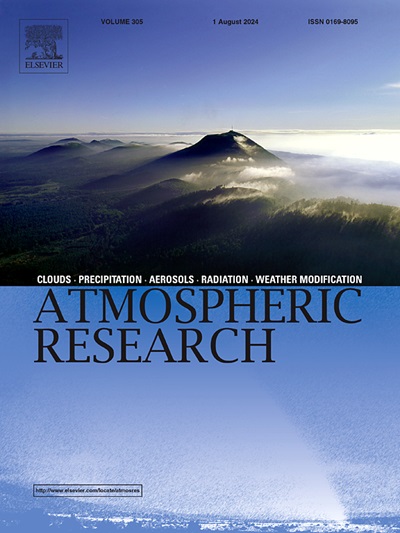山区 GPM 卫星降水产品的机器学习降尺度:重庆案例研究
IF 4.4
2区 地球科学
Q1 METEOROLOGY & ATMOSPHERIC SCIENCES
引用次数: 0
摘要
高质量的降水数据对水文学、气象学和生态学研究至关重要。然而,在地形复杂的山区,由于站点设置困难导致站点数量有限,通过站点数据插值得出的网格降水数据可靠性较低。目前的卫星降水产品空间分辨率低,不适合中小尺度的水文和气象研究。在具有显著时空异质性的山区应用这些产品则更具挑战性。为此,降尺度卫星降水产品已成为获取这些地区降水精确空间分布信息的有效方法。本研究采用随机森林(RF)、极梯度提升(XGBoost)和长短期记忆(LSTM)算法,对重庆地区的 GPM 日降水量产品进行先校准后降尺度分析。最终,GPM 产品的空间分辨率从 0.1°提高到 0.01°(∼1 公里)。研究结果表明(1)台站校正后的 GPM 降水量产品比原始 GPM 产品性能更好,更接近台站实测数据;(2)在实际应用中,LSTM 降尺度算法可以在不影响精度的情况下有效提高空间分辨率,而 RF 和 XGBoost 在提高空间分辨率时会造成相当大的精度损失;(3)三种算法的降尺度结果与校正后的 GPM 降水图一致,显著改善了降水的空间细节。其中,LSTM 方法的结果在降水空间分布上表现出更强的连续性,更贴近降水分布特征。总之,LSTM 算法在研究区域的 GPM 降水量产品降尺度方面表现出更大的潜力。这项研究为站点覆盖稀少、地形地貌复杂的山区提供了一种有前景的高质量降水数据生成方案。本文章由计算机程序翻译,如有差异,请以英文原文为准。
Machine-learning downscaling of GPM satellite precipitation products in mountainous regions: A case study in Chongqing
High-quality precipitation data are essential for research in hydrology, meteorology and ecology. Nevertheless, in mountainous regions with intricate terrain, the reliability of gridded precipitation data derived from station data interpolation is low due to the limited number of stations caused by the difficulty of station setup. Current satellite precipitation products suffer from low spatial resolution, making them unsuitable for hydrological and meteorological research at small and medium scales. Their application in mountainous regions with significant spatiotemporal heterogeneity is even more challenging. To this end, downscaling satellite precipitation products has become an effective method for obtaining accurate spatial distribution information of precipitation in these regions. This study employs a method of first calibration followed by downscaling analysis of GPM daily precipitation product in the Chongqing area using random forest (RF), extreme gradient boosting (XGBoost), and long short-term memory (LSTM) algorithms. Ultimately, the spatial resolution of GPM product is improved from 0.1° to 0.01° (∼1 km). The findings demonstrate that: (1) the station-calibrated GPM precipitation product performed better than the original GPM product, and it is closer to the station measurements; (2) in practical applications, the LSTM downscaling algorithm can effectively enhance spatial resolution without compromising accuracy, whereas RF and XGBoost incur considerable accuracy loss when enhancing spatial resolution; (3) the downscaled results from all three algorithms were consistent with the calibrated GPM precipitation maps and significantly improved the spatial details of precipitation. Among them, the results of the LSTM method exhibited greater continuity in the spatial distribution of precipitation, aligning more closely with the characteristics of precipitation distribution. In summary, the LSTM algorithm demonstrates greater potential for the downscaling of GPM precipitation product in the study area. This research provides a promising high-quality precipitation data generation scheme for mountainous regions with sparse station coverage and complex terrain and landforms.
求助全文
通过发布文献求助,成功后即可免费获取论文全文。
去求助
来源期刊

Atmospheric Research
地学-气象与大气科学
CiteScore
9.40
自引率
10.90%
发文量
460
审稿时长
47 days
期刊介绍:
The journal publishes scientific papers (research papers, review articles, letters and notes) dealing with the part of the atmosphere where meteorological events occur. Attention is given to all processes extending from the earth surface to the tropopause, but special emphasis continues to be devoted to the physics of clouds, mesoscale meteorology and air pollution, i.e. atmospheric aerosols; microphysical processes; cloud dynamics and thermodynamics; numerical simulation, climatology, climate change and weather modification.
 求助内容:
求助内容: 应助结果提醒方式:
应助结果提醒方式:


